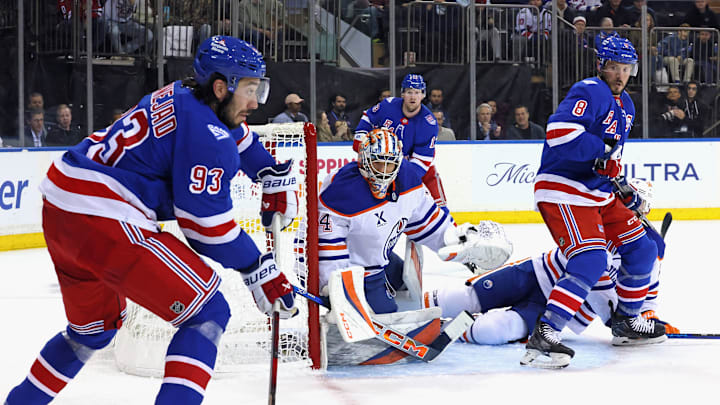I don't care that the Rangers scored two power-play goals in Saturday's 6–1 win over Pittsburgh. I don't care; they were goalied by Charlie Lindgren of the Washington Capitals or Stuart Skinner of the Edmonton Oilers in 1-0 hockey games (Edmonton made it 2-0 on an empty netter). I know they'll score in bunches soon. I don't care that it's only Game 5 of the season. Still, I care that they're 0-for-7 on the man-advantage at home, scoreless in three games at MSG, and somehow look more dangerous shorthanded than with the extra man. I care they're 2 for 14 on the power play this season.
This has gone from an engine to an anchor over the last two years and five games. Anyone watching night to night can see the issue: it's not clicking, and hasn't for a while.
The mirage of "two goals"
Let's start there. Yeah, they scored twice in Pittsburgh. On paper, that looks like progress. However, that was fool's gold. One was a broken play off a screen, and the other resulted from a second unit scramble that had more to do with chaos than structure. The first unit looked toothless.
Rangers have scored less goals at MSG than Flyers have scored on the PP🤯 https://t.co/btt0Pjyqar
— kat triolo (@kattriolo) October 15, 2025
You can dress it up with analytics — zone entries, expected goals, shot attempts — but the eye test tells the truth. They can't set up. They can't connect passes. They look hesitant, static, predictable. It's the same script every time: Adam Fox to Artemi Panarin, Panarin to Mika Zibanejad, fake one-timer, reset, repeat. The puck moves, but the threat doesn't.
If you're thinking, "Well, maybe they miss Chris Kreider," who's got four goals as an Anaheim Duck on the power play in three tilts, stop. Kreider's net-front work is valuable, but it only matters once the unit establishes possession and flow — something they've been utterly incapable of doing.
Four goals in his first three games.
— NHL (@NHL) October 15, 2025
Chris Kreider is fitting in well as a member of the @AnaheimDucks 🦆 #NHLFaceOff pic.twitter.com/zUfP68kQYv
That latter approach, which included Adam Fox shooting the puck, helped the Rangers rank top-five in the NHL in 2023–24 at a crisp 26.4% conversion rate. Yet those days feel long gone. Since the start of last season, it's been downhill. They dipped to 17.6% last year (28th in the league) and haven't shown efficient improvement thus far. The numbers don't lie, but they also don't tell the whole story.
The first unit — Panarin, Zibanejad, Fox, Miller, and Trocheck (when healthy) — is built to create chaos through structure. The 1-3-1 setup is supposed to spread defenses thin, force rotations, and generate inside chances. Yet, it's a bad game of keep-away, and the movement is slow.
Structure vs. execution
David Quinn hasn't overhauled the system — it's still a 1-3-1 foundation. The "ideal" version of this power play has Panarin attacking the middle, Zibanejad rotating into shooting space, Fox orchestrating like a quarterback, and constant movement around the slot. The reality version is that Panarin is hovering up top. Zibanejad glued to the circle—Fox static. No traffic. No second chances. That's execution failure.
I agree. I trust David Quinn w/ the #NYR PP unit; w/ some more reps I believe they'll be fine. That's the one thing Quinn was good at as Rangers head coach
— Rangers Digest (@RangersDigestYT) October 15, 2025
The Rangers' five-on-five game looks fast, physical, and connected even though they're not scoring yet. The penalty kill's elite. Igor's Igor. Yet the power play — the part of this team that used to terrify opponents — looks like it's stuck in slow motion. Until it's fixed, then, the stat sheet might say "two power-play goals," but anyone watching knows the truth: This power play stinks.
That said, the last power play in Tuesday's loss to Edmonton showed some life, as the puck movement was cleaner, rotations crisper, and there was a bit more creativity in how they switched spots up top. For the first time this year, it looked like there was a plan instead of panic.
It's definitely progress from the stale setup we saw at the start of the season, and I'm not too worried yet. It's one area where Quinn has consistently gotten right behind an NHL bench: building a functional power play. Give this group a few more reps and a little chemistry, and they'll be fine.
